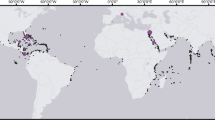Abstract
Tigriopus brevicornis (O. F. Müller) were collected in 1992 from rock pools close to U.M.B.S. Millport, Isle of Cumbrae, U.K. and acclimated to various combinations of salinity and temperature for at least 1 wk prior to laboratory experiments. Higher salinities of acclimation enhanced tolerance to high salinity stress, while tolerance of low salinities was hardly affected by acclimation salinity. Acclimation to low temperature (10°C) extended the survivable salinity range for T. brevicornis. High-salinity acclimation enhanced the survivable temperature range. Copepods acclimated to 60‰ survived significantly lower and higher temperatures than did 34‰-acclimated individuals. At high temperature, 75‰-acclimated female copepods had the highest median lethal temperature, 38.9°C. Females were significantly more resistant to high temperatures than males. The copepods were seen to have a very low median lethal temperature when frozen into solid ice for 2 h; 50% mortality occurred at-16.9°C in 10°C, 34‰-acclimated T. brevicornis. Salinity preference experiments demonstrated an ability to discriminate between salinities differing by as little as 3‰. Copepods acclimated to 34‰ chose salinities near their acclimation salinity; individuals acclimated to 5‰ favoured slightly higher salinities, while copepods acclimated to 60‰ chose rather lower salinities.
Similar content being viewed by others
References
Aarset, A. V., Aunaas, T. (1987). Physiological adaptations to low temperature and brine exposure in the circumpolar amphipod Gammarus wilkitzkii. Polar Biol. 8: 129–133
Aarset, A. V., Torres, J. J. (1989). Cold resistance and metabolic responses to salinity variations in the amphipod Eusirus antarcticus and the krill Euphausia superba. Polar Biol. 9: 491–497
Bettison, J. C., Davenport, J. (1976). Salinity preference in gammarid amphipods with special reference to Marinogammarus marinus (Leach). J. mar. biol. Ass. U.K. 56: 135–142
Burton, R. S., Feldman, M. W. (1982). Changes in free amino acid concentrations during osmotic response in the intertidal copepod Tigriopus californicus. Comp. Biochem. Physiol. 73A (3): 441–445
Carli, A., Fiori, A. (1977). Morphological analysis of the two Tigriopus species found along the European coasts. Nature, Milan 68: 101–110
Cossins, A. R., Bowler, L. (1987). Temperature biology of animals. Chapman & Hall, London
Crowe, J. H. (1971). Anhydrobiosis: an unsolved problem. Am. Nat. 105: 563–572
Davenport, J. (1972). Salinity tolerance and preference in the porcelain crabs, Porcellana platycheles and Porcellana longicornis. Mar. Behav. Physiol. 1: 123–138
Davenport, J. (1979). Cold resistance in Gammarus duebeni Liljeborg. Astarte 12: 21–26
Finney, D. J. (1970). Probit analysis. Cambridge University Press, Cambridge
Fraser, J. H. (1936). The occurrence, ecology and life history of Tigriopus fulvus (Fischer). J. mar. biol. Ass. U.K. 20: 523–536
Ganning, B. (1971). Studies on chemical, physical and biological conditions in Swedish rock pool ecosystem. Ophelia 9: 51–105
Goolish, E. M., Burton, R. S. (1989). Energetics of osmoregulation in an intertidal copepod: effects of anoxia and lipid reserves on the pattern of free amino acid accumulation. Funct. Ecol. 3: 81–89
Gross, W. J. (1957). A behavioral mechanism for osmotic regulation in a semi terrestrial crab. Biol. Bull. mar. biol. Lab., Woods Hole 133: 268–274
Kasahara, S., Akiyama, T. (1976). Notes on dormancy in the adults of Tigriopus japonicus. J. Fac. Fish. Anim. Husb. Hiroshima Univ. 15: 57–65
Le Dean, L., Devineau, J. (1985). In search of standardisation: a comparison of toxicity bioassay on two marine crustaceans (Palaemon serratus and Tigriopus brevicornis). Revue Trav. Inst. (scient. tech.) Pêch. marit. 49 (3–4): 187–198
Matutani, K. (1961 a). Studies on the temperature and salinity resistance of Tigriopus japonicus. I. Changes in heat resistance in relation to acclimation temperatures of Tigriopus japonicus reared at 20°C. Physiol. Ecol. 9: 35–38
Matutani, K. (1961 b). Studies on the temperature and salinity resistance of Tigriopus japonicus. II. Changes in heat resistance in relation to acclimation temperatures of Tigriopus japonicus reared at four different temperatures. Physiol. Ecol. 9: 39–43
Mututani, K. (1962). Studies on the temperature and salinity resistance of Tigriopus japonicus. IV. Heat resistance in relation to salinity, of Tigriopus japonicus acclimated to dilute and concentrated sea waters. Physiol. Ecol. 10: 63–67
McDonough, P. M., Stiffler, D. F. (1981). Sodium regulation in the tidepool copepod Tigriopus californicus. Comp. Biochem. Physiol. 69A: 273–277
McLusky, D. S. (1970). Salinity preference in Corophium volutator. J. mar. biol. Ass. U.K. 50: 747–752
Nagaraj, M. (1988). Combined effects of temperature and salinity on the complete development of Eurytemora velox (Crustacea: Calanoidea). Mar. Biol. 99: 353–358
Ranade, M. R. (1957). Observations on the resistance of Tigriopus fulvus (Fischer) to changes in temperature and salinity. J. mar. biol. Ass. U.K. 36: 115–119
Takeda, N. (1958). Thermal adaptation in the marine copepod, Tigriopus japonicus Mori. Physiol. Ecol. 6: 49–54
Author information
Authors and Affiliations
Additional information
Communicated by T.M. Fenchel, Helsingør
Rights and permissions
About this article
Cite this article
Damgaard, R.M., Davenport, J. Salinity tolerance, salinity preference and temperature tolerance in the high-shore harpacticoid copepod Tigriopus brevicornis . Marine Biology 118, 443–449 (1994). https://doi.org/10.1007/BF00350301
Received:
Accepted:
Issue Date:
DOI: https://doi.org/10.1007/BF00350301




